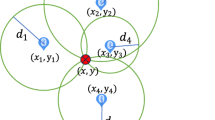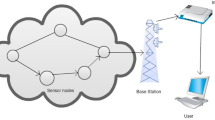Abstract
To solve the problem of estimating the locations of sensor nodes in wireless sensor networks where most nodes are without an effective positioning device, a novel range-free localization algorithm—weighted centroid localization based on compressive sensing (WCLCS) is proposed. WCLCS makes use of compressive sensing to get decomposition coefficients between each nonbeacon node and beacon nodes. According to these coefficients, WCLCS algorithm decides the weighted value of each beacon node for Centroid and estimates the locations of nonbeacon nodes. The simulation results show that WCLCS has better localization performance than LSVM.











Similar content being viewed by others
References
Bahl, P., & Padmanabhan, V. N. (2000). RADAR: An in-building RF-based user location and tracking system. In Proceedings of the IEEE INFOCOM (pp. 775–784).
Mourad, F., Snoussi, H., & Richard, C. (2011). Interval-based localization using RSSI comparison in MANETs. IEEE Transactions on Aerospace and Electronic Systems, 47(4), 2897–2910.
Wang, T. (2012). Novel sensor location scheme using time-of-arrival estimates. IET Signal Processing, 6(1), 8–13.
Savvides, A., Han, C., & Srivastava, M. B. (2001). Dynamic fine-grained localization in ad-hoc networks of sensors. In Proceedings of the 7th annual international conference on mobile computing and networking (pp. 166–179).
Xu, E., Ding, Z., & Dasgupta, S. (2011). Reduced complexity semidefinite relaxation algorithms for source localization based on time difference of arrival. IEEE Transactions on Mobile Computing, 10(9), 1276–1282.
Dragos, N., & Badri, N. (2003). Ad hoc positioning system (APS) using AoA. In Proceedings of the Info Com 2003 Francisco (pp. 1734–1743).
Bulusu, N., Heidemann, J., & Estrin, D. (2000). GPS-less low cost outdoor localization for very small devices. IEEE Personal Communications Magazine, 7(5), 28–34.
Jun, W., Urriza, P., Yuxing, H., & Cabric, D. (2011). Weighted centroid localization algorithm: Theoretical analysis and distributed implementation. IEEE Transactions on Wireless Communications, 10(10), 3403–3413.
Xinyu, Y., Qingru, K., & Xiangjun, D. (2010). A improved weighted centroid location algorithm. Journal of Xi’an Jiaotong University, 44(8), 1–4.
He, T., Huang, C., & Blum, B. M. (2003). Range-free localization schemes for large scale sensor networks. In Proceedings of the Mobi Com ‘03 (pp. 81–95).
Meertens, L., & Fitzpatrick, S. (2004). The distributed construction of a global coordinate system in a network of static computational nodes from inter-node distances. Technical report. Palo Alto, CA: Kestrel Institute.
Bulusu, N., Byehkovskiy, V., & Estrin, D. (2002). Sealable ad hoc deployable RF-based localization. In Proceedings of the Grace Hopper celebration of women in computing conference. http://www.isi.edu/~johnh/PAPERS/Bulusu02a.pdf.
Tran, D. A., & Nguyen, T. (2008). Localization in wireless sensor networks based on support vector machines. IEEE Transactions on Parallel and Distributed Systems, 19(7), 981–994.
Goldenberg, D., Bihler P., Cao, M., Fang, J., Anderson, B., Morse, A. S., et al. (2006). Localization in sparse networks using sweeps. In Proceedings of the ACM Mobi Com (pp. 110–121).
Yang, Z., Liu, Y., & Li, X. (2010). Beyond trilateration: On the localizability of wireless ad-hoc networks. IEEE/ACM Transactions on Networking, 18(6), 1806–1814.
Chen, H., HongYang, C., & LingGe, J. (2010). Distributed wireless sensor network localization via sequential greedy optimization algorithm. IEEE Transactions on Signal Processing, 58(6), 3328–3340.
Donoho, D. L. (2006). Compressed sensing. IEEE Transactions on Information Theory, 52(4), 1289–1306.
Candes, E. (2006). Compressive sampling. International Congress of Mathematicians, 3, 1433–1452.
Candes, E., & Plan, Y. (2011). A probabilistic and RIP less theory of compressed sensing. IEEE Transactions on Information Theory, 57(11), 7235–7254.
Chen, S. B., Donoho, D. L., & Saunders, M. A. (1998). Atomic decomposition by basis pursuit. SIAM Journal on Scientific Computing, 20(1), 33–61.
Mallat, S., & Zhang, Z. (1993). Matching pursuit with time-frequency dictionaries. IEEE Transactions on Signal Process, 41(12), 3397–3415.
Tropp, J. A., & Gilbert, A. C. (2007). Signal recovery from random measurements via orthogonal matching pursuit. IEEE Transactions on Information Theory, 53(12), 4655–4666.
Cands, E., & Tao, T. (2006). Near-optimal signal recovery from random projections: Universal encoding strategies? IEEE Transactions on Information Theory, 52(12), 5406–5425.
IEEE standard online resource provided by IEEE 802.15 WPAN. http://www.ieee802.org/15/pub/TG4.html.
Acknowledgments
This work was supported by the National Natural Science Foundation of China under Grant No. 61077079; the Ph.D. Programs Foundation of Ministry of Education of China under Grant No. 20102304110013 and the Fundamental Research Funds for the Central Universities under Grant No. HEUCF1208.
Author information
Authors and Affiliations
Corresponding author
Rights and permissions
About this article
Cite this article
Zhao, C., Xu, Y. & Huang, H. Weighted centroid localization based on compressive sensing. Wireless Netw 20, 1527–1540 (2014). https://doi.org/10.1007/s11276-014-0686-1
Published:
Issue Date:
DOI: https://doi.org/10.1007/s11276-014-0686-1




